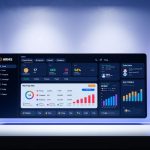Did you know that using an Applicant Tracking System (ATS) can make hiring 30% more efficient? In today’s job market, the right ATS is key to a smooth hiring process.
Choosing between Lever and Workable for your ATS comparison can be tough. Both offer great features to make hiring easier. But they meet different needs.
This article will compare Lever vs Workable in detail. We’ll look at their features, prices, and how users feel about them. This will help you pick the best Applicant Tracking System for your company.
Key Takeaways
- Understand the key features of Lever and Workable ATS.
- Compare the pricing models of both systems.
- Learn about user experiences and satisfaction rates.
- Discover which ATS is more scalable for growing businesses.
- Identify the best ATS for your organization’s specific needs.
The Importance of Choosing the Right ATS
Choosing the right Applicant Tracking System (ATS) is key for any company wanting to improve its hiring process. An ATS does more than just handle job ads and resumes. It’s a partner in finding the best candidates.
The right ATS makes hiring better and faster. With many choices, knowing what to look for is important.
Key Factors in ATS Selection
Several things matter when picking an ATS. Look for ease of use, customization options, and integration with HR systems. It should also have strong analytics to track and improve the hiring process.
- Ease of use for recruiters and hiring managers
- Customization to fit the organization’s specific needs
- Integration with other HR tools and systems
- Advanced analytics for data-driven decisions
How the Right ATS Impacts Recruitment
The right ATS changes the hiring game. It automates tasks, improves finding candidates, and makes the candidate experience better. With the right recruitment software, companies can hire faster, better, and more efficiently.
Choosing the right ATS is more than picking a tool. It’s about getting a hiring tool that matches your goals and helps attract and keep top talent.
Lever Overview: Features and Capabilities
Lever is a top-notch ATS solution that boosts hiring efficiency. It simplifies the recruitment process, helping companies find and hire the best talent.
Core Functionality
Lever has a solid set of tools for managing the hiring process. It allows for job posting on various job boards and candidate sourcing from different channels. It also tracks applicant progress to streamline hiring.
The platform has advanced candidate screening tools. Recruiters can check candidate qualifications and fit. Customizable workflows let companies adjust the hiring process to fit their needs.
User Interface and Experience
Lever’s interface is easy to use, making it simple for recruiters to manage hiring. It has a clean and modern design with clear menus. This simplifies the recruitment process.
The platform is also mobile-optimized, allowing recruiters to use it on the go. This is key in today’s fast-paced recruitment world, where quick decisions are vital.
Integration Capabilities
Lever’s integration capabilities are a major feature. It connects smoothly with other HR tools and systems. This includes HRIS systems, job boards, and productivity software. It streamlines recruitment and cuts down on admin work.
By linking with other HR tools, Lever creates a unified recruitment ecosystem. Data flows easily between systems. This makes the hiring process more efficient, reduces errors, and improves the candidate experience.
Workable Overview: Features and Capabilities
Workable is a top applicant tracking system that makes hiring easier. It has many tools to help businesses improve their hiring process.
Core Functionality
Workable’s main features help make hiring more efficient. It allows for posting jobs on many boards and finding candidates. It also has a simple interface for managing applications.
Candidates can be tracked and managed through every stage of the hiring process, from start to finish.
The platform also has advanced reporting and analytics. This helps hiring managers make better decisions. They can see things like time-to-hire and where candidates come from. This helps businesses improve their hiring strategies.
User Interface and Experience
Workable is easy to use, thanks to its simple interface. The dashboard is customizable, so users can focus on what’s important.
The platform is also mobile-friendly. This means users can access it anywhere, anytime. This is key in today’s fast business world, where hiring decisions need to be quick.
Integration Capabilities
Workable works well with other HR and business tools. It integrates with services like LinkedIn, Slack, and Zapier, among others. This helps businesses create a unified recruitment system that fits their workflows.
By linking Workable with other tools, businesses can automate tasks. This reduces manual work and boosts efficiency. This streamlined approach to recruitment lets teams focus on finding the best talent.
Lever vs Workable: Quick Comparison Table
Choosing between Lever and Workable for your recruitment needs is important. We’ve made a table to help you see their differences and how they perform.
Key Differences at a Glance
The table below shows the main differences between Lever and Workable. It covers their core functions, user interface, and how well they integrate with other tools.
| Feature | Lever | Workable |
|---|---|---|
| Core Functionality | Advanced candidate sourcing, AI-driven matching | Streamlined job posting, applicant tracking |
| User Interface | Customizable pipelines, intuitive design | Simple, user-friendly interface |
| Integration Capabilities | Seamless integrations with HR tools, LinkedIn | Integrates with popular HR software, job boards |
Ratings Breakdown
Lever and Workable both get good reviews. Lever is great for finding candidates and managing pipelines. Workable is easy to use and good for posting jobs.
Winner by Category
Lever is the best for advanced candidate sourcing and customizable pipelines. Workable is great for businesses that want an easy-to-use ATS for posting jobs.
In conclusion, picking between Lever and Workable depends on your recruitment needs and what you value most.
Pricing Comparison: Lever vs Workable
Lever and Workable have different pricing plans for various business needs. It’s important to compare their costs. Knowing their pricing structures helps businesses improve their recruitment processes.
Lever Pricing Plans
Lever offers a pricing model that fits your organization’s needs. The cost depends on the number of users and the features you need.
- Customized Pricing: Lever’s pricing isn’t public. It’s given after they assess your needs.
- Scalability: The price changes based on your business’s size and needs.
Workable Pricing Plans
Workable has clear pricing plans. They’re based on the number of job openings and the features you need.
- Starter Plan: Good for small businesses or startups. It costs $99 a month for one job opening.
- Premium Plans: For bigger companies, Workable offers custom pricing. It depends on job openings and features needed.
Value for Money Analysis
When looking at the value of Lever and Workable, think about your organization’s needs. Lever’s custom pricing is great for big companies with complex hiring needs. Workable’s clear pricing is better for smaller businesses or simple ATS needs.
| Feature | Lever | Workable |
|---|---|---|
| Pricing Model | Customized | Transparent tiered pricing |
| Cost | Quote-based | Starts at $99/month |
User Experience and Ease of Use
Choosing the right ATS is more than just looking at features. It’s also about how easy it is to use and the overall user experience. Lever and Workable aim to make recruitment easier, but they do it in different ways.
Lever’s User Interface
Lever is famous for its intuitive interface that makes recruitment simpler. Its dashboard is tidy and well-organized. This makes it easier for users to handle candidates and keep track of progress.
The user-friendly design of Lever’s platform lets recruiters find the best talent without hassle. They don’t get stuck in complicated software.
Workable’s User Interface
Workable also has a streamlined interface that improves the recruitment process. Its features are easy to access. This lets users post jobs, track applicants, and work with their team efficiently.
Workable’s clean design and straightforward navigation make it popular among recruiters. They like its simplicity and effectiveness.
Learning Curve Comparison
Both Lever and Workable are easy to adopt when it comes to the learning curve. But Lever’s detailed onboarding might be better for teams that need to learn fast.
In the end, choosing between Lever and Workable depends on your team’s needs and what they prefer in ATS usability and user experience.
Pros and Cons of Lever vs Workable
When looking at applicant tracking systems, it’s key to know the good and bad of Lever and Workable. Both have their strong points and weak spots, which we’ll cover here.
Lever Advantages and Disadvantages
Lever Pros
- Efficient Candidate Sourcing: Lever makes finding great candidates easy.
- User-Friendly Interface: Its interface is simple, making hiring easier.
- Advanced Analytics: Lever’s analytics help track hiring success and guide decisions.
Lever Cons
- Steep Learning Curve for Advanced Features: While easy to start, learning advanced features can be tough.
- Limited Customization Options: Some find the customization options too narrow for their needs.
Workable Advantages and Disadvantages
Workable Pros
- Comprehensive Recruitment Tools: Workable has many tools for hiring, like posting jobs and tracking candidates.
- Excellent Customer Support: Users love Workable’s quick and helpful customer service.
- Integrations: It works well with many other apps, making it more useful.
Workable Cons
- Cost: Workable can be expensive, which might be a problem for big companies or those with complex hiring needs.
- Overwhelming Features for Small Businesses: Small businesses might find too many features to handle.
By looking at the pros and cons of Lever and Workable, companies can choose the best ATS for their hiring needs.
Best Fit and Use Cases
Finding the right ATS is key in recruitment. Lever and Workable are top choices, but they serve different needs. They fit various business strategies and sizes.
Lever is Best For
Lever is great for businesses needing customization and scalability in hiring.
Startups and Small Businesses
Lever is perfect for startups and small businesses. It’s easy to use and helps streamline hiring without a big HR team.
Marketing Teams
Marketing teams will love Lever’s advanced analytics and customizable workflows. It helps track where candidates come from and improve recruitment marketing.
Agencies
Recruitment agencies will find Lever’s integration and user-friendly design helpful. It manages lots of placements and client needs well.
Workable is Best For
Workable is for businesses needing a full recruitment solution. It focuses on teamwork and productivity.
Enterprise Organizations
Enterprise organizations will find Workable’s AI and detailed reports useful. They help manage complex hiring across many locations.
Large Teams
Large teams will appreciate Workable’s tools for teamwork. Features like shared candidate pipelines and customizable interview kits make hiring smoother.
Content Production at Scale
For content production at scale, Workable’s tools are a big help. They manage job postings and talk to candidates efficiently, even with lots of hires.
Choosing between Lever and Workable depends on your business’s needs and goals. Knowing what each ATS offers helps make the right choice for your hiring strategy.
- Lever is ideal for startups, marketing teams, and agencies seeking flexibility and customization.
- Workable is best suited for enterprise organizations, large teams, and businesses with high-volume hiring needs.
Conclusion: The Verdict on Lever vs Workable
Lever and Workable are both strong Applicant Tracking Systems. Lever is great for big companies because of its advanced features and integrations. Workable is better for smaller businesses because it’s easy to use and affordable.
Choosing between Lever and Workable depends on what your company needs. If you want an easy-to-use system, Workable might be best. But if you need more advanced features, Lever is a better fit.
In the end, the right ATS for you depends on your business needs. Knowing the differences between Lever and Workable helps you choose the best system for your recruitment goals.

